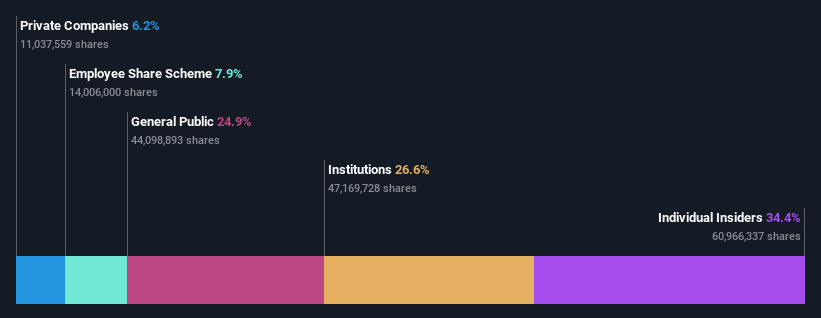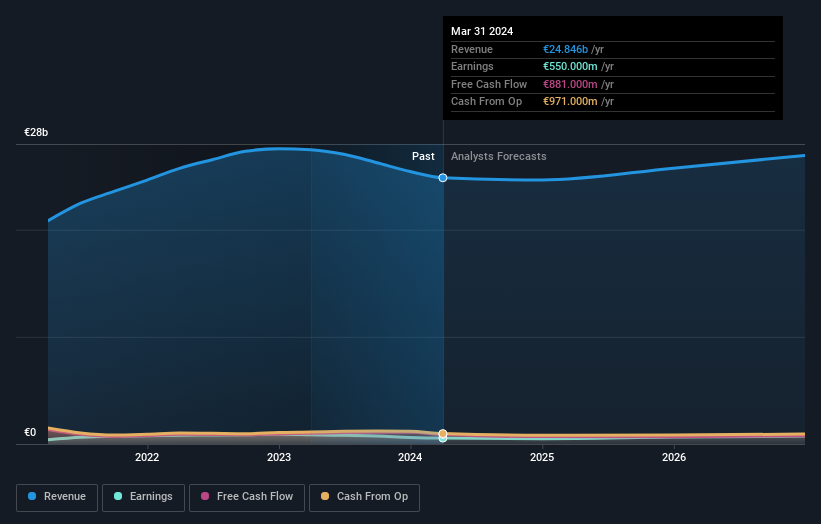With 34% ownership, insiders at Randstad N.V. (AMS:RAND) are pretty optimistic and have been buying recently
Key Insights
Insiders appear to have a vested interest in Randstad's growth, as seen by their sizeable ownership
The top 4 shareholders own 52% of the company
If you want to know who really controls Randstad N.V. (AMS:RAND), then you'll have to look at the makeup of its share registry. And the group that holds the biggest piece of the pie are individual insiders with 34% ownership. In other words, the group stands to gain the most (or lose the most) from their investment into the company.
Notably, insiders have bought shares recently. This could be interpreted as insiders anticipating a rise in stock prices in the near future.
Let's delve deeper into each type of owner of Randstad, beginning with the chart below.
View our latest analysis for Randstad
What Does The Institutional Ownership Tell Us About Randstad?
Institutional investors commonly compare their own returns to the returns of a commonly followed index. So they generally do consider buying larger companies that are included in the relevant benchmark index.
Randstad already has institutions on the share registry. Indeed, they own a respectable stake in the company. This implies the analysts working for those institutions have looked at the stock and they like it. But just like anyone else, they could be wrong. When multiple institutions own a stock, there's always a risk that they are in a 'crowded trade'. When such a trade goes wrong, multiple parties may compete to sell stock fast. This risk is higher in a company without a history of growth. You can see Randstad's historic earnings and revenue below, but keep in mind there's always more to the story.
Hedge funds don't have many shares in Randstad. The company's largest shareholder is Frits Goldschmeding, with ownership of 34%. In comparison, the second and third largest shareholders hold about 7.9% and 6.2% of the stock.
On looking further, we found that 52% of the shares are owned by the top 4 shareholders. In other words, these shareholders have a meaningful say in the decisions of the company.
Researching institutional ownership is a good way to gauge and filter a stock's expected performance. The same can be achieved by studying analyst sentiments. There are a reasonable number of analysts covering the stock, so it might be useful to find out their aggregate view on the future.
Insider Ownership Of Randstad
The definition of an insider can differ slightly between different countries, but members of the board of directors always count. The company management answer to the board and the latter should represent the interests of shareholders. Notably, sometimes top-level managers are on the board themselves.
I generally consider insider ownership to be a good thing. However, on some occasions it makes it more difficult for other shareholders to hold the board accountable for decisions.
It seems insiders own a significant proportion of Randstad N.V.. Insiders own €2.9b worth of shares in the €8.4b company. That's quite meaningful. It is good to see this level of investment. You can check here to see if those insiders have been buying recently.
General Public Ownership
The general public, who are usually individual investors, hold a 25% stake in Randstad. While this group can't necessarily call the shots, it can certainly have a real influence on how the company is run.
Private Company Ownership
Our data indicates that Private Companies hold 6.2%, of the company's shares. Private companies may be related parties. Sometimes insiders have an interest in a public company through a holding in a private company, rather than in their own capacity as an individual. While it's hard to draw any broad stroke conclusions, it is worth noting as an area for further research.
Next Steps:
It's always worth thinking about the different groups who own shares in a company. But to understand Randstad better, we need to consider many other factors. Case in point: We've spotted 1 warning sign for Randstad you should be aware of.
But ultimately it is the future, not the past, that will determine how well the owners of this business will do. Therefore we think it advisable to take a look at this free report showing whether analysts are predicting a brighter future.
NB: Figures in this article are calculated using data from the last twelve months, which refer to the 12-month period ending on the last date of the month the financial statement is dated. This may not be consistent with full year annual report figures.
Have feedback on this article? Concerned about the content? Get in touch with us directly. Alternatively, email editorial-team (at) simplywallst.com.
This article by Simply Wall St is general in nature. We provide commentary based on historical data and analyst forecasts only using an unbiased methodology and our articles are not intended to be financial advice. It does not constitute a recommendation to buy or sell any stock, and does not take account of your objectives, or your financial situation. We aim to bring you long-term focused analysis driven by fundamental data. Note that our analysis may not factor in the latest price-sensitive company announcements or qualitative material. Simply Wall St has no position in any stocks mentioned.

 Yahoo Finance
Yahoo Finance 

